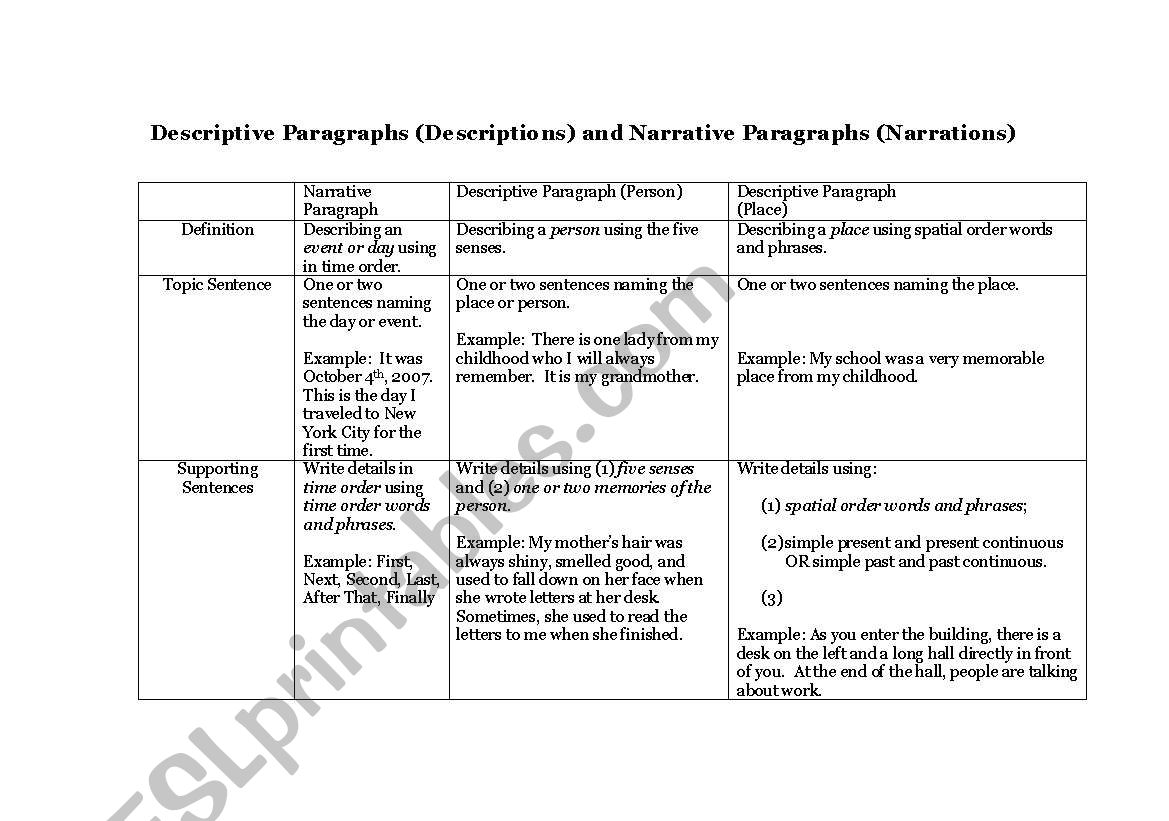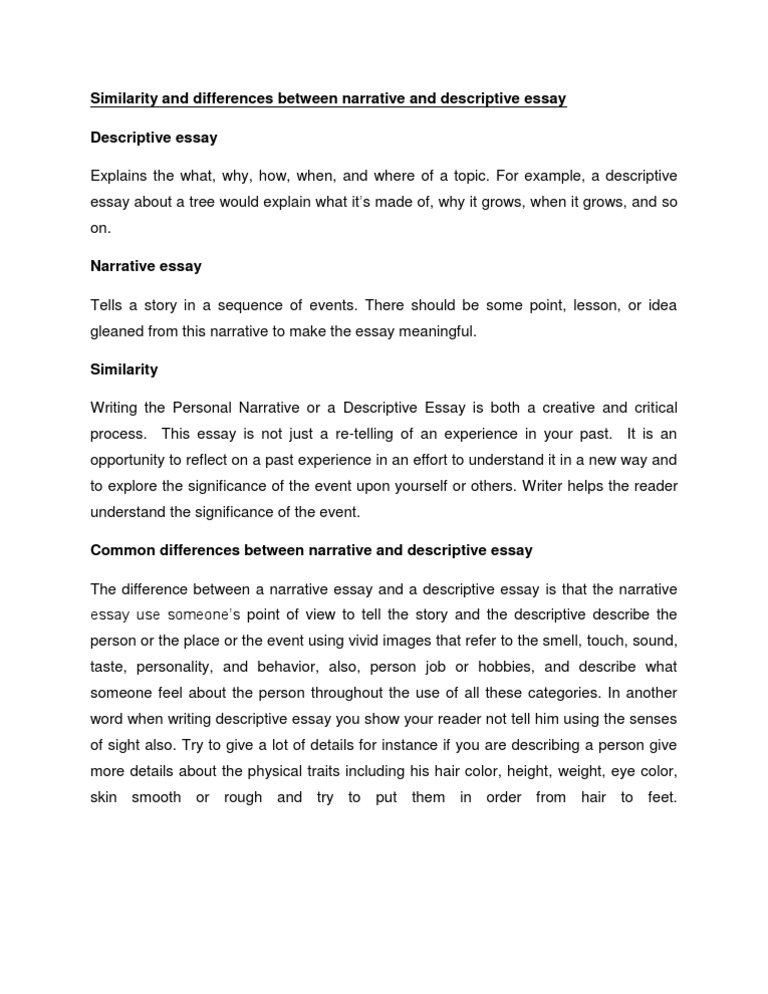
The most common types of writing assignments students encounter in composition classes are exposition, argument, narration and description. While all these modes allow a writer to explain an idea or · Narrative paragraphs will include action, events and exciting descriptive words. These paragraphs help keep the reader engaged in the story. Narrative paragraphs are similar to descriptive paragraphs (and a paragraph may actually be both at once), but a narrative paragraph tends to offer the reader more background information, such as past events that lead up to or cause events in the In addition to thinking about narrative mode writing, you also want to think about the descriptive mode. Descriptive mode paragraphs provide details about specific persons, places, and things. This mode can be used in any type of writing
Difference Between Narrative and Descriptive Essay | Compare the Difference Between Similar Terms
The narrative mode is writing that is driven by a story. Thus, narrative writing is storytelling. There are many reasons why authors may choose to write in the narrative mode.
These narratives may be designed to entertain or to educate, to reflect on an experience, or to record that experience for posterity. This is powerful writing.
As you know, narratives can be stories that are either fictional or nonfictional. In contrast, a personal narrative may have a looser structure. Regardless, both kinds of narratives need to contain a logical internal structure, meaning a logical sequence of events depicted to tell a story that makes sense.
In a fictional narrative, you start by setting the stage. Then the story will move towards the rising action, when events begin to unfold.
There will be the climax, where everything comes together and the action reaches a breaking point. This will be followed by the falling action, when the story moves towards resolution. Everything will end with a conclusion, where all the threads of the plot are untangled, and all the questions your readers might have had about the plot are resolved.
In nonfiction, similar structures are often deployed. You might see a story begin with a problem that the author describes descriptive and narrative paragraph to solve, followed by an explanation of why this is significant.
Then there might be a movement towards solving this problem, and finally descriptive and narrative paragraph conclusion that resolves the issue and discusses the overall significance. Although fiction and nonfiction have their differences, descriptive and narrative paragraph, there are some good rules to follow for writing both kinds of narrative:.
When the Bears came home, they noticed descriptive and narrative paragraph their porridge was missing. Where's my food!
Upstairs, Goldilocks awoke, startled by the loud roars she heard from down below. That dialogue helps explain why Goldilocks wakes up startled. When I woke up, descriptive and narrative paragraph, I didn't know that the day would be memorable, but by the time I was done drinking my coffee, the phone had rung to deliver the news. I got in! I was happy, but knew that things were going to change. The details at the beginning set the stage for something momentous to happen to this author, in addition to showing the speed with which this event moved.
Note as well that the dialogue here not only explains more of the plot, but also indicates the descriptive and narrative paragraph significance of the story for these two characters. You might even assume that the purpose of this story is to explain that transformative descriptive and narrative paragraph can be bittersweet.
Finally, note that you probably want to read more to see what happens next between the speaker and the mother, which means that this is a good narrative. In addition to thinking about narrative mode writing, you also want to think about the descriptive mode. Descriptive mode paragraphs provide details about specific persons, places, and things. This mode can be used in any type of writing. Like the narrative mode, the descriptive mode has some rules that you should follow to ensure it is successful:.
I came home from work tired, but my dog was happy to see me. After I said hello to her, we went for a walk. It was cold and snowing, but we didnt' mind. I enjoyed watching her play, and that made me feel more energetic. This version is much more interesting, descriptive and narrative paragraph, as there are many descriptive words and sensory details used.
There is even dialogue. All of that makes this a much more enjoyable story in the descriptive mode. I trudgged home from work, my eyes gluey with exhaustion, but was immediately met by the wiggling tail and sloppy kisses of my hound dog. Outside, the snow was beginning to pile up around us, turning the whole world shiny and white.
Bundled up in her fur coat, my dog didn't mind. And watching her bounce through the snow drifts, I felt a warm glow of joy in my chest. Before I knew it, descriptive and narrative paragraph, I was wide awake. summary In this tutorial, you learned that the narrative mode is used to tell a story.
There are two types of narrative : fictional and nonfictional. While these two types have their differences, there are some important rules for bothdescriptive and narrative paragraph, such as avoiding unnecessary details, knowing your focus before you start, and balancing dialogue with explanations.
You also learned about the descriptive mode of writing, which involves embedding vivid details into your paragraphs to make them more enjoyable and engaging for your readers. Good luck! Sign In. Previous Next Sophia Tutorial. Martina Shabram. Writing Effective Narrative and Descriptive Paragraphs.
Author: Sophia Tutorial. Description: Identify the elements of effective narrative and descriptive writing. Descriptive and narrative paragraph tutorial will cover how descriptive and narrative paragraph write both narratives that are true and narratives that are fiction, as well as how to write vivid details descriptive and narrative paragraph the descriptive mode, descriptive and narrative paragraph.
The specific areas of focus include: Narrative Mode Types of Narrative Fictional Nonfictional Rules for Both Types Descriptive Mode. EXAMPLE Think of the story of the three bears. You begin by learning where they live. Then you see conflict arise when Goldilocks arrives and eats their porridge. Then there is the climax, when the bears return home to find Goldilocks sleeping in the baby bear's bed.
Finally, there is resolution, as Goldilocks runs away from the house and escapes becoming a bowl of porridge herself. EXAMPLE Think about the purportedly true story of George Washington chopping down the cherry tree. Then there is the conflict when his parents confront him about the tree.
Finally, you see the conclusion and moral of the story, which tells you why this is significant. George admits the truth and accepts punishment because he refuses to tell a lie. EXAMPLE You could use the descriptive mode to tell about a vacation you had.
You could also use this mode in a piece of professional writing when describing the way a product works and who it might be marketed towards.
In this tutorial, you learned that the narrative mode is used to tell a story. Source: This work is adapted from Sophia author Martina Shabram.
Sample Narrative descriptive and narrative paragraph Descriptive Paragraphs. Presentation Mode Download. Zoom Out. More Information Less Information. Descriptive Mode Writing that provides details concerning a specific person, place, or thing. Narrative Mode Writing that is driven by a story. Rating Header. SOPHIA is a registered trademark of SOPHIA Learning, LLC. About Contact Us Privacy Policy Terms of Use.
Descriptive and narrative writing
, time: 4:16Difference Between Narrative and Descriptive Essay

The most common types of writing assignments students encounter in composition classes are exposition, argument, narration and description. While all these modes allow a writer to explain an idea or · Both narrative and descriptive essay can be written by any age group, as they do not contain many facts or information. They are usually used in creative writing activities for students. The main difference between narrative and descriptive essay is that a descriptive essay describes a certain person, an object or a scene while a narrative essay narrates a story · Narrative paragraphs will include action, events and exciting descriptive words. These paragraphs help keep the reader engaged in the story. Narrative paragraphs are similar to descriptive paragraphs (and a paragraph may actually be both at once), but a narrative paragraph tends to offer the reader more background information, such as past events that lead up to or cause events in the
No comments:
Post a Comment